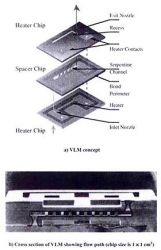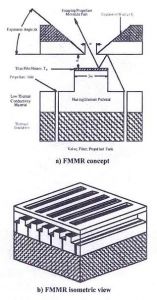An emerging trend in the space industry today is the shift from large satellites to smaller microsatellites. It is envisioned that groups of microsatellites could communicate with each other, allowing them to increase their functionality and creating very adaptable networks that could replace the functions of larger, more complex spacecraft. The stringent power, weight, and space requirements of these microsatellites create a need for new small scale propulsion methods. Widely used chemical rocket engines, both mono- and multi-propellant, are being scaled down for use on microspacecraft. A more experimental approach involves the use of MEMS technology to create compact thrusters. Resistojets, ion engines, chemical rockets, and other systems are all being modified and scaled using MEMS technology to create useful new methods of micropropulsion.
When most people are asked to think about the future of space exploration, they probably conjure mental images straight out of one of the many science fiction films that address the subject. One might imagine huge starships carrying thousands of people from planet to planet, with massive glowing engines and possibly some kind of ”warp drive” propelling them at the speed of light. Ask an engineer, however, and one would probably get a dramatically different response. When engineers today consider the future of spaceflight, they are beginning to think much smaller. There has recently been a great deal of interest among members of the scientific community in building microspacecraft, space vehicles that weigh less than 100 kilograms [1]. Though these tiny spacecraft cannot carry passengers and certainly have no space for huge engines, they are quickly becoming the future of space exploration.
Bigger Is Not Always Better
There are many advantages to using microspacecraft instead of the more conventional large satellites and space vehicles. Microspacecraft are lighter and therefore far easier and cheaper to launch. Additionally, a platoon or constellation of microspacecraft can link together to perform the same tasks that a larger satellite might [2]. This offers the advantage that, if a single element of the system is damaged, only one of the microspacecraft must be replaced to restore functionality. In contrast, if part of a large satellite is damaged, often the entire spacecraft must be replaced or a costly and dangerous repair mission must be initiated. Besides replacing larger, more complicated satellites, groups of microspacecraft can also be used to monitor and repair other spacecraft, like the Space Shuttle or the International Space Station [3]. For example, imagine a network of microspacecraft that could fly around the space shuttle, detecting and repairing damage to its hull. These spacecraft could easily prevent disasters like the recent Columbia explosion and eliminate the need for dangerous spacewalks, such as those used during the recent flight of Discovery or those used to repair the Hubble Space Telescope.
While engineers might primarily be interested in microspacecrafts because of their simplicity, American taxpayers will be interested in microspacecrafts because they will be getting more for their money – the simplicity in design decreases the cost of spaceflight while increasing the amount of scientific knowledge gained per mission. Although the price of spaceflight might seem like a distant, unfamiliar issue to most Americans, reducing the cost will actually have a huge effect on the lives of many people. For example, communication satellites power services like cellular phones, satellite television, Internet, and radio, and reducing the cost while increasing the reliability of these satellites can only be beneficial to users. Beyond simple convenience, satellites are responsible for various types of valuable research that affect people’s everyday lives. Satellites monitor weather patterns, track ocean currents, and create increasingly accurate maps of the earth, thereby improving our understanding of the world around us. This understanding could one day increase our ability to predict events like the deadly Gulf Coast hurricanes or to understand the effects of global warming. Imagine the effect on scientific progress as satellites become cheaper and easier to produce, launch, and maintain; this is exactly the impact that microspacecraft may have as they increase in prominence.
So About that Warp Drive…
One of the most enduring images associated with space flight is the massive fiery launch of a rocket or Space Shuttle. As one might expect, however, this large, spectacular form of propulsion is not really suited to tiny microspacecraft. As such, one of the most challenging obstacles engineers must overcome in order to make the microspacecraft dream a reality is the development of a useful propulsion system that is small and simple. Additionally, the system must be designed to use little power, as space for solar cells and other power supplies is limited on a tiny spacecraft. With these constraints in mind, there are a number of systems that are being developed for use on microspacecraft. These systems may seem unspectacular – in fact, many of them produce so little thrust that it would be imperceptible even if you put your hand right next to them – but they are really quite useful for maneuvering a tiny spacecraft in the vacuum of space.
But We Can Keep Our Rockets, Right?
Chemical propulsion is the method that powers traditional rockets, and several scaled-down versions of this technology have been proposed as micropropulsion systems. There are a few different types of chemical propulsion, but by far the most familiar is the solid rocket engine, the type of engine that has been used since the early days of the space program and is still used today on the space shuttle. Solid rocket engines are a very widespread technology – fireworks and model rockets, for example, use solid rocket engines. Solid rockets consist of a solid propellant that is oxidized or burned to produce a rapidly moving exhaust that pushes the rocket forward [1]. Once a solid rocket starts to burn, it cannot be stopped or restarted, and multiple stages must be used if more than one burn is desired [1]. Of course, this increases the complexity of the propulsion system, which is not desirable for a microspacecraft.
To improve the solid rocket design, engineers have worked to create more advanced chemical micropropulsion systems that use one or more liquid or gaseous propellants. Multiple-propellant systems typically use two or three chemicals that, when combined and forced through a nozzle, produce a fast moving exhaust. Multi-propellant systems tend to be fairly complex, with stringent requirements for storage since mixing the chemicals at the wrong time may have explosive results. On the upside, they provide a relatively high specific impulse, a measure of fuel efficiency [1]. Chemical engines designed to use a single liquid or gaseous propellant work by passing the propellant through a catalyst, which decomposes the propellant and produces thrust [1]. These systems are much simpler and more reliable than multi-propellant engines because using a single propellant makes storage easier. The specific impulse is lower, however [1]. Liquid and gaseous chemical engines are more versatile than solid rockets because the reactions can be stopped and started at will by controlling the flow of propellants.
A New Idea: Microchips as Engines?
Although it is tempting to simply miniaturize the tried-and-true chemical propulsion techniques, engineers are also making progress in more experimental forms of propulsion. Many of these experimental systems have been inspired by Micro Electro-Mechanical Systems, or MEMS, technology. MEMS technology involves creating very small components, usually with features measured on the scale of micrometers (roughly the width of a human hair). These components are frequently fabricated in the form of silicon chips, much like the chips found in computers and other electronics [1]. The small size and light weight of MEMS components make them ideal for creating propulsion systems for microspacecraft. The chips are often no larger than a quarter, but in this space engineers can fit highly sophisticated propulsion systems (see Fig. 1). Chips can be bonded together, allowing nozzles, heaters, valves, filters, and controls to be sandwiched into very compact units [1].
One type of MEMS thruster that is being developed by engineers at the Jet Propulsion Laboratory and the Air Force Research Laboratory is called a resistojet [1]. A resistojet works by heating gas molecules to increase their energy before expelling them through a nozzle [1]. One style of resistojet incorporates three silicon chips mounted on top of one another. The bottom chip is covered in heating elements, the middle chip has a long, winding channel carved in it, and the top chip features a small nozzle etched above the end of the channel [1]. Gas flows through the winding channel, gaining kinetic energy as it contacts the heating elements. The energy added to the gas molecules causes their speed to increase as they reach the end of the channel and exit through the nozzle [1]. This whole setup consists of just three microchip-sized elements ”glued” together. Combined with a propellant storage system, this may constitute a complete propulsion system, demonstrating the simplicity of MEMS designs.
An interesting variation of the MEMS resistojet is the Free Molecular Microresistojet or FMMR (see Fig. 2) [4]. Rather than a simple channel and nozzle, the FMMR uses a single chip that features a grid of long slots surrounded by heaters. Using multiple slots instead of a single nozzle helps to prevent the problem of clogging, which can be fatal when the nozzle is very small [4].
Gas molecules at a very low pressure impact the heater elements as they exit through the slots, gaining energy and thus velocity [1]. The tiny heater elements used in this process require power as low as two watts [1]. Resistojets can also store their propellant as a liquid, which reduces the volume required for storage – liquids are much denser than gases – and contributes to making the propulsion system even more compact and relatively power efficient [1].
Engineers are also working to design other types of MEMS propulsion systems, including bipropellant and cold gas chemical thrusters (similar to the traditional chemical engines), as well as ion engines, field emitters for accelerating electrons, and tiny arrays of solid propellant thrusters mounted on thin chips [1]. Most of these systems still require a great deal of testing and experimentation, but the flexibility and compact size of MEMS technology make it a very promising platform for these systems as well as future propulsion designs.
Full Speed Ahead!
As engineers begin designing microspacecraft to take the place of large satellites, it is clear that success will hinge upon the development of innovative propulsion methods that take into account the strict power, size, and weight requirements inherent in building small space vehicles. The technology that is currently being explored ranges from the obvious scaling down of conventional chemical engines to the innovative use of MEMS technology to create a wide range of compact propulsion systems. Although most of the micropropulsion systems discussed here are driven by particles as small as electrons, ions, and single molecules of gas, they are doing as much to propel the world into the future as those huge rockets that once sent the Apollo astronauts to the moon.
References
[1] J. Mueller. ”Thruster Options for Microspacecraft: A Review and Evaluation of State-of-the-Art and Emerging Technologies.” in Micropropulsion for Small Spacecraft:Progress in Astronautics and Aeronautics, vol. 187. M. Micci and A. Ketsdever, Ed. AIAA: Reston, VA, 2000, pp. 27-120.
[2] J. Wong and H. Reed. ”University Micro-/Nanosatellite as a Micropropulsion Testbed.” in Micropropulsion for Small Spacecraft. Progress in Astronautics and Aeronautics., vol. 187. M. Micci and A. Ketsdever, Ed. AIAA: Reston, VA, 2000, pp. 201.
[3] M. Micci and Andrew D. Ketsdever, “Preface” in Micropropulsion for Small Spacecraft. Progress in Astronautics and Aeronautics., vol. 187. M. Micci and A. Ketsdever, Ed. AIAA: Reston, VA, 2000, pp. xvii.
[4] A. Ketsdever, D. Wadsworth, and E.P. Muntz. ”Predicted Performance and Systems Analysis of the Free Molecule Micro-Resistojet.” in Micropropulsion for Small Spacecraft. Progress in Astronautics and Aeronautics., vol. 187. M. Micci and A. Ketsdever, Ed. AIAA: Reston, VA, 2000, pp. 204-230.




